Vatican Museums - The CHIARAMONTI section
(Edited)
Hello Hivers,
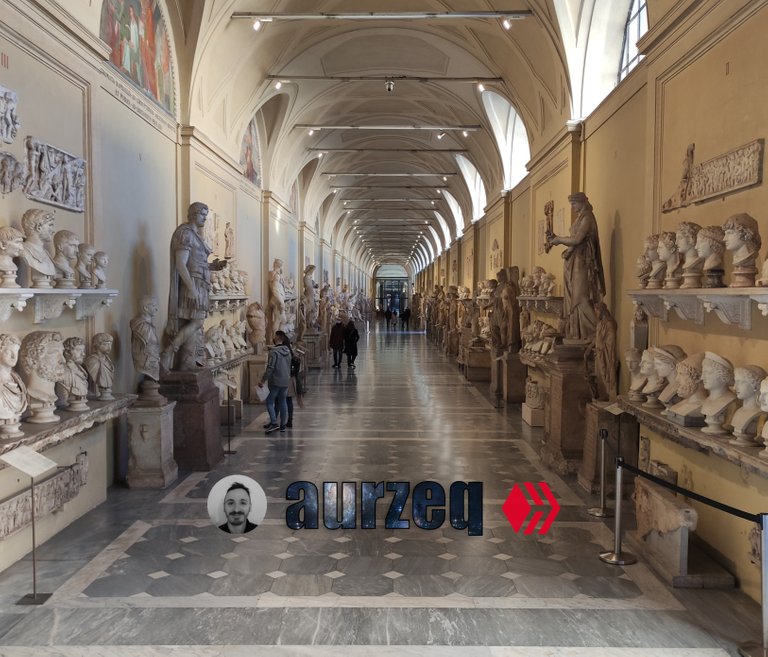
Today I would like to continue my post on the Vatican Museums. For those who missed the previous one, I leave the link below:
Oggi vorrei continuare il mio post relativo ai Musei vaticani. Per chi si fosse perso il precedente, lascio di seguito il link:
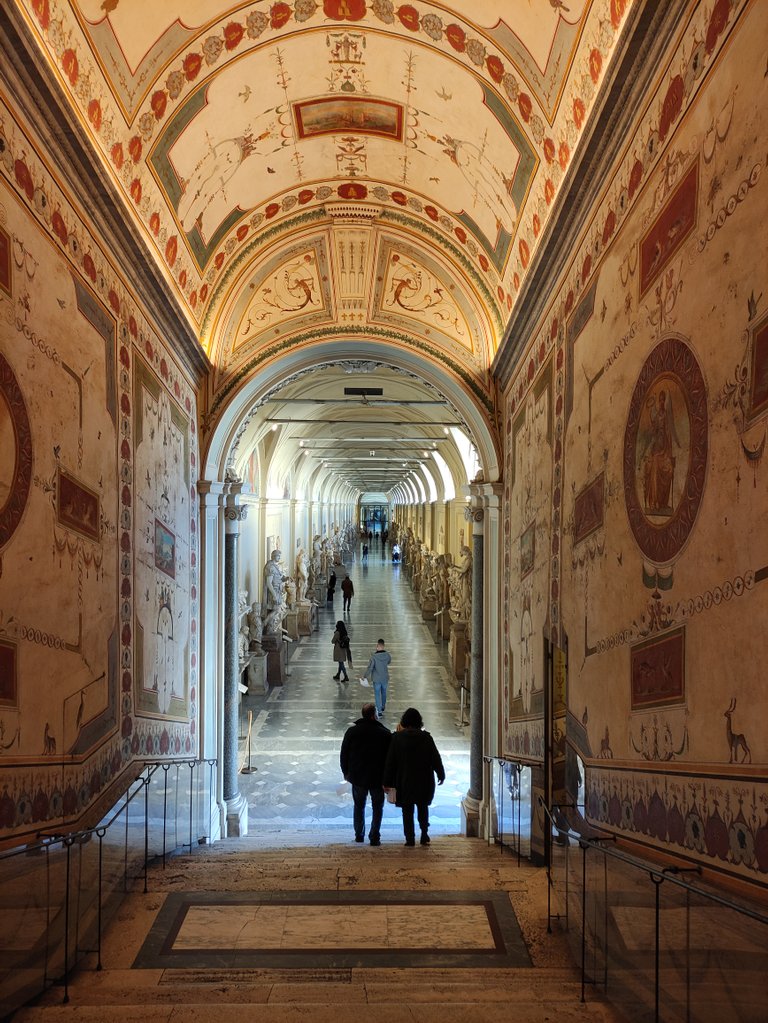
ITA - L'ingresso al Corridoio.
The first section of the Vatican Museums, the one I described in the post is the section defined as Chiarimonti Museum , which takes its name from the house of its founder, Pius VII Chiaramonti, who entrusted its organization to Canova.
This part of the museums includes the Corridor , divided into 60 sections, where you can admire an endless series of statues, busts, sarcophagi, reliefs, etc .: about 800 Greco-Roman works. Let's go over the main ones together trying to give a minimum of context and explanation:
La prima sezione dei Musei vaticani, quella che ho descritto nel post la sezione definita come Museo Chiarimonti, che prende nome dal casato del suo fondatore, Pio VII Chiaramonti, che ne affidò l'ordinamento al Canova.
Di questa parte dei musei fa parte il Corridio, diviso in 60 sezioni, dve può ammirare una interminabile serie di statue, busti, sarcofagi, rilievi ecc.: circa 800 opere greco-romane. Ripercorriamo insieme quelle principali cercando di dare un minimo di contesto e spiegazione:

ITA - Una scultura di Eracle con Telefo bambino.
The presence of Heracles recalled the myths of Rome's origins, in particular alluding to the victory of civilisation over the barbarism of ancient Latium. The god Heracles, with club and lion skin, is holding his son Telephus, born of the priestess Auge. She was forced to abandon the child in the mountains of Arcadia, where he was fed by a hind and later found by his father. Telephos, who became king of Mysia, was the protagonist of a complex myth full of variations that led him to be involved in the Greek expeditions against Troy.
La presenza di Eracle si richiamava ai miti delle origini di Roma, in particolare alludeva alla vittoria della civiltà sulle barbarie del Lazio antico. Il dio Heracles, con clava e pelle leonina, tiene in braccio il figlio Telefo, nato dalla sacerdotessa Auge. Ella fu costretta ad abbandonare il piccolo sui monti dell'Arcadia, dove fu nutrito da una cerva e in seguito venne ritrovato dal padre. Telefo, divenuto re della Misia, fu protagonista di un mito complesso e ricco di varianti che lo porto ad essere coinvolto nelle spedizioni dei Greci contro Troia.
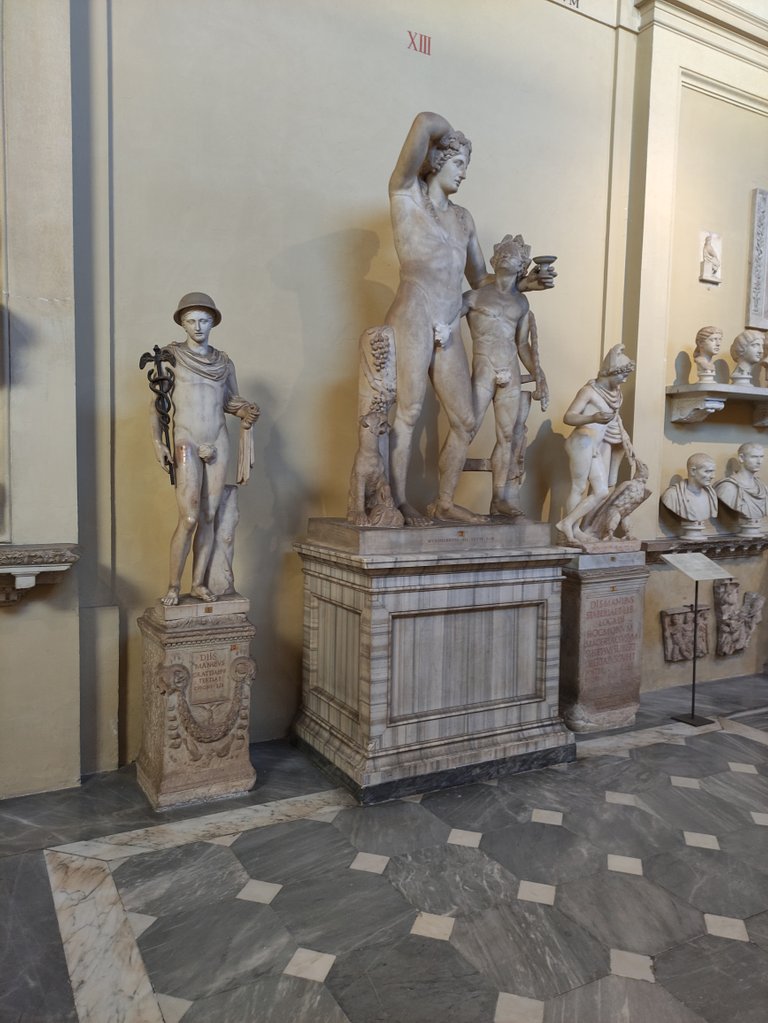
ITA - Dioniso con un satiro
This group of sculptures instead represents Dionysus with a satyr. Found in 1769 near Frascati on the Casal Morena estate on the Via Latina, the sculpture reworks motifs from Hellenistic art and was perhaps part of the statuary of an ancient Roman villa.
To his right we see Ganymede with an eagle. While grazing a flock on Mount Ida, near Troy, Ganymede was abducted by Zeus and transported to Olympus, where he became the cupbearer of the gods. The sculpture, executed around the middle of the 2nd century AD, reworks iconographies from Greek masterpieces of the 4th-3rd centuries BC.
Questo gruppo di sculture invece rappresenta Dioniso con un satiro. Rinvenuto nel 1769 nei pressi di Frascati della tenuta di Casal Morena sulla via Latina, la scultura rielabora motivi dell'arte ellenistica ed era forse pertinente all'arredo statuario di un'antica villa romana.
Alla sua destra vediamo Ganimede con l'aquila. Mentre pascolava un gregge sul monte Ida, nei pressi di Troia, Ganimede rapito da Zeus e trasportato sull'Olimpo divenne il coppiere degli dei. La scultura, eseguita intorno alla metà del II secolo dopo Cristo rielabora iconografie proprie dei capolavori Greci del IV-III secolo a.C..
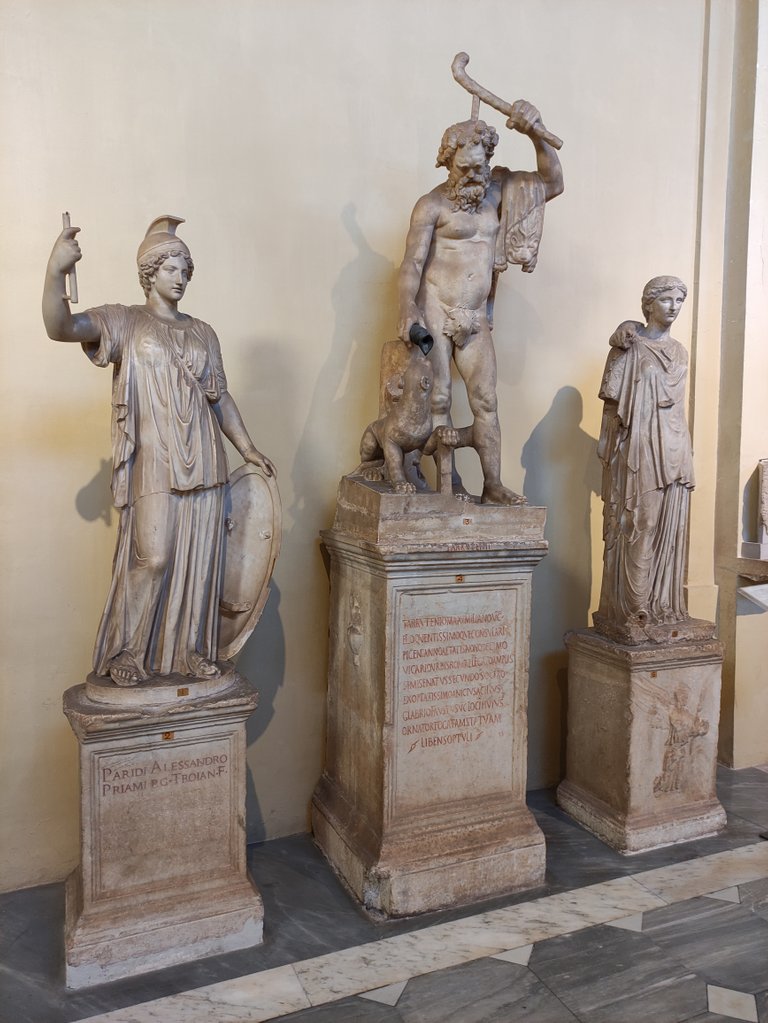
ITA - Atena, Sileno e Igea
In this group, on the other hand, we can see from the left the statue of Athena, that of Silenus depicted with a panther and Hygieia, who is supposed to have been depicted with her father, the medical god Asclepius, whose hand remains resting on Hygieia's right shoulder.
In questo gruppo invece possiamo vedere da sinistra la statua di Atena, quella di Sileno raffigurato assieme ad una pantera e Igea che si suppone dovesse essere raffigurata insieme al padre, il dio medico asclepio del quale resta la mano appoggiata sulla spalla destra di Igea.
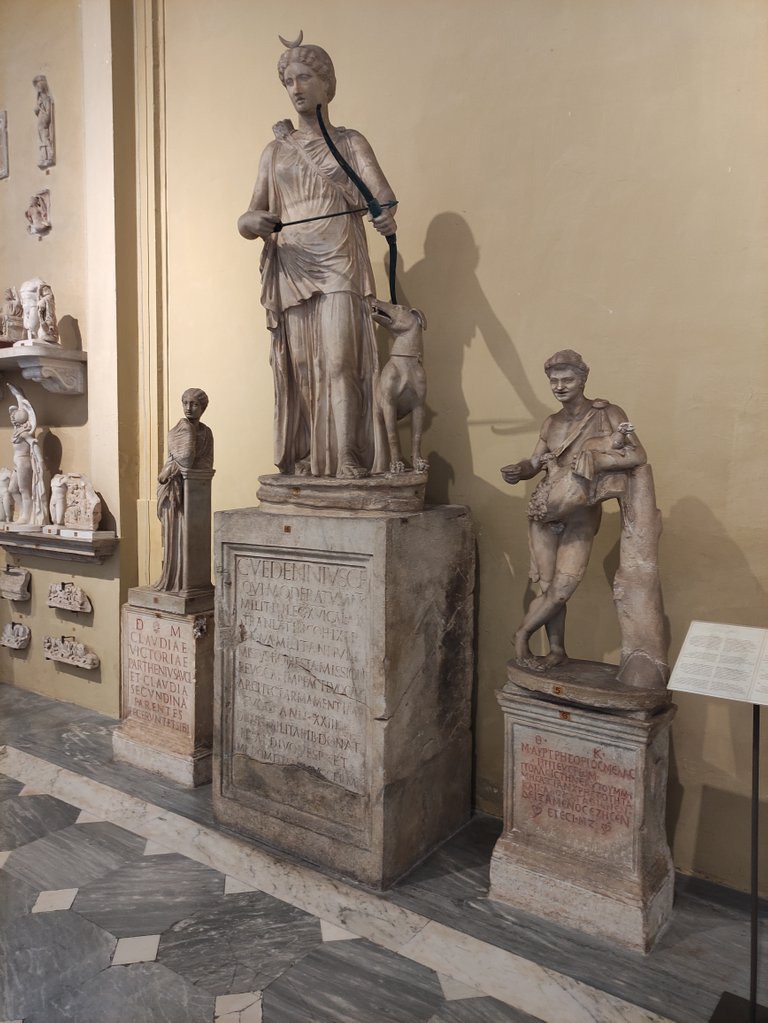
ITA - Polimnia, Artemide e satiro.
In this group we see from the left a statuette of Musa (Polyhymnia, muse of sacred poetry), in the centre a statue of Artemis and on the right a statuette of a satyr holding a small panther.
In questo gruppo vediamo da sinistra una statuetta di Musa (Polimnia, musa della poesia sacra), al centro una statua di Artemide e a destra la statuetta di un satiro che sta tenendo in braccio una piccola pantera.

ITA - Busto di Oceano e sarcofago.
In this image we see in the center the bust of Oceanus, which is thought to have appeared to decorate a fountain, and below it, a sarcophagus with a Dionysian scene, in particular Dionysus and Ariadne observing a scene of two satyrs and Pan crushing grapes. On the left and right, in a rural landscape, two figures are depicted inside caves and surrounded by satyrs and maenads, possibly the gods Libero and Libera, the Italic equivalent of the Greek couple Dionysus and Ariadne.
In questa immagine vediamo al centro il busto di Oceano, che si pensa visualizzato per decorare una fontana, e al di sotto un sarcofago con una scena Dionisiaca, in particolare Dioniso e Arianna osservano una scena di pigiatura dell'uva da parte di due satiri e di Pan. A sinistra e a destra, in un paesaggio agreste due personaggi sono raffigurati all'interno di grotte e circondati da satiri e da menadi, si tratta forse degli dei Libero e Libera, corrispondente italico della coppia greca Dioniso e Arianna.
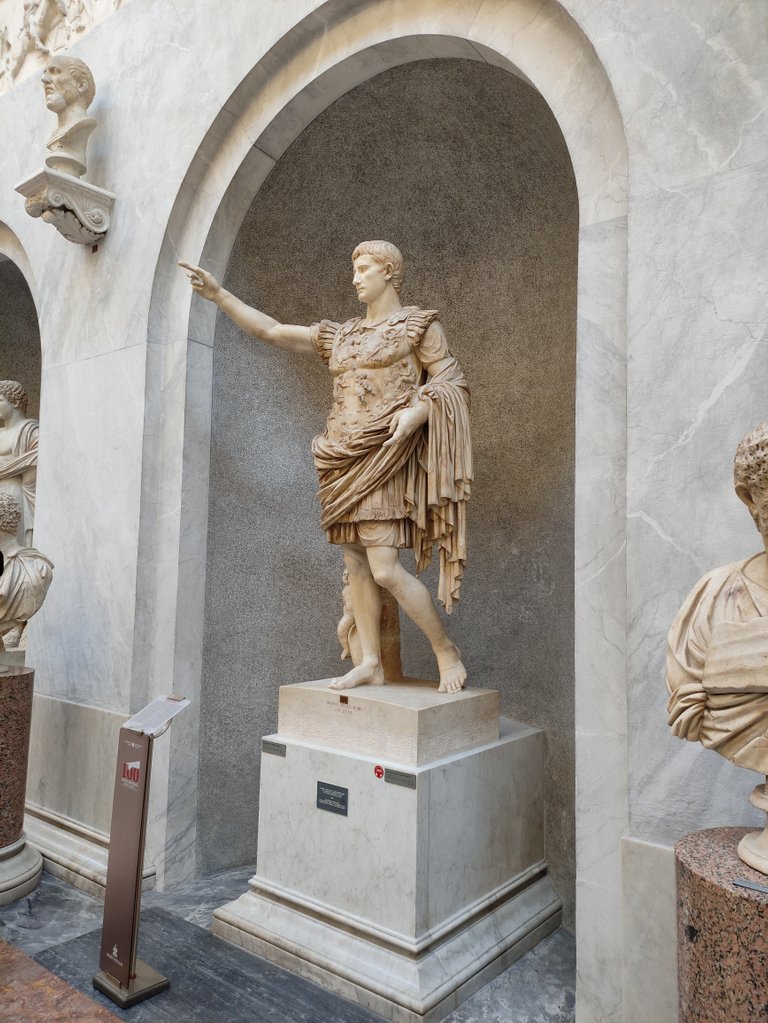
ITA - Augusto di Prima Porta.
Here we see Augustus of the First Gate represented. The sculpture depicts the emperor in the act of addressing the soldiers, dressed in armour and with his cloak around his hips. In relief on the armour, the king of the Parthians returns to a Roman general the insignia snatched from Crassus in 53 BC, during the disastrous battle of Carre.
Qui vediamo invece rappresentato Augusto di Prima porta. La scultura raffigura l'imperatore nell'atto di parlare ai soldati, vestito di corazza e con il mantello attorno ai fianchi. A rilievo sulla corazza, il re dei Parti restituisce a un generale romano le insegne strappate a Crasso nel 53 a. C., durante la rovinosa battaglia di Carre.
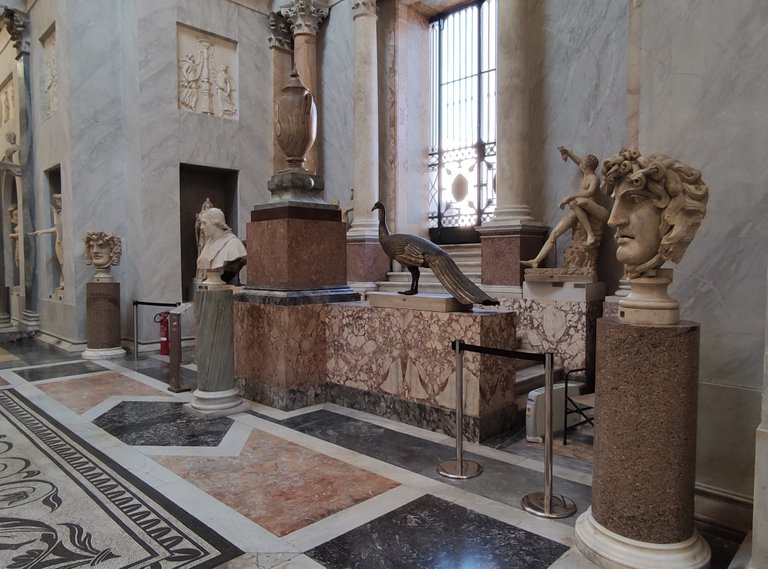
ITA - Pavoni e Medusa.
The two gilded bronzes representing peacocks are kept here. These bronzes are distinguished by an extreme quality of execution, expressed in the realistic details and refined presentation of the plumage. These characteristics and their symbolic value of mortality reinforce the hypothesis that they were originally part of the decorative apparatus of Hadrian's tomb.
Next to them is the head of Medusa, the monster from Greek mythology that could petrify anything with a simple glance.
Qui vengono invece conservati i due bronzi dorati rappresentanti dei pavoni. Tali bronzi si segnalano per un estrema qualità di esecuzione, che si esprime nei dettagli realistici è nella raffinata presentazione del piumaggio. Tali caratteristiche e la loro valenza simbolica di mortalità rafforzano l'ipotesi di un originaria pertinenza all'apparato decorativo del sepolcro di Adriano.
Vicino ad essi è collocata anche la testa di medusa il mostro della mitologia greca che poteva pietrificare qualsiasi cosa con un semplice sguardo.

ITA - Detaglio della testa di Medusa.
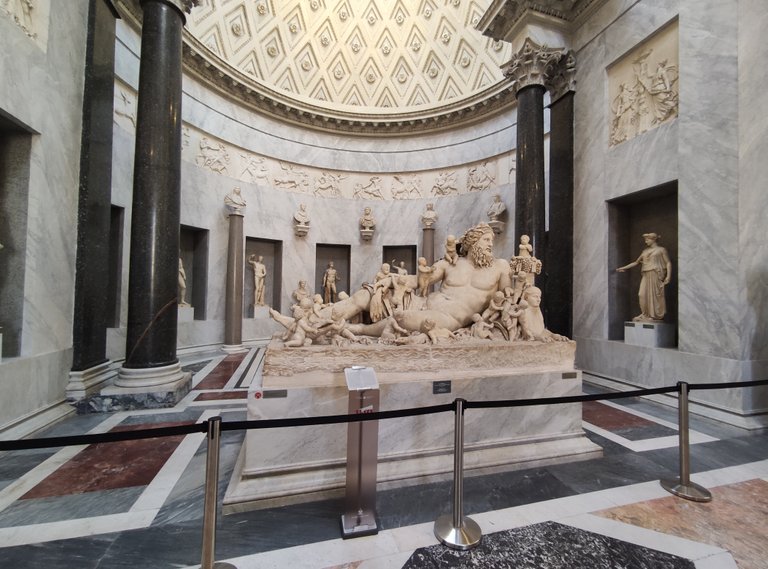
ITA - Statua del Nilo.
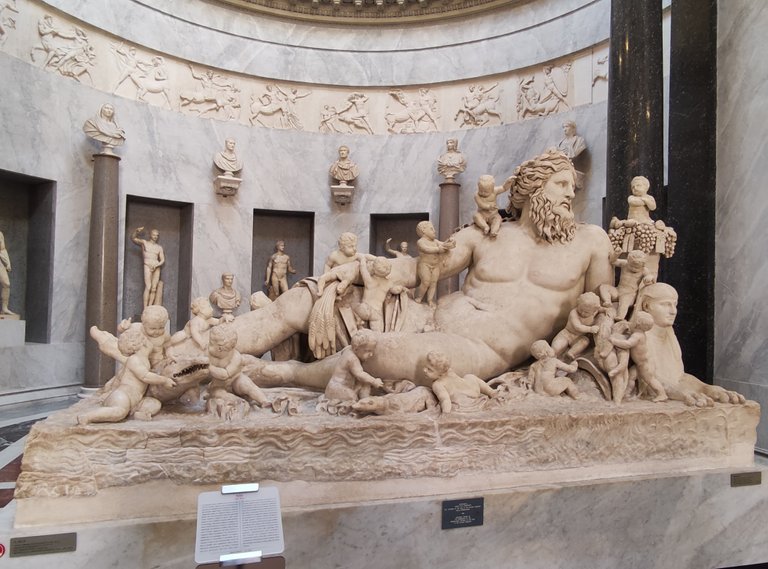
ITA - Primo piano sulla Statua del Nilo.
The colossal statue of the Nile was found in 1513 in Campo Marzio. The river is depicted as an old man lying on his side, with a cornucopia full of fruit in his left hand and ears of corn in his right hand. The land of Egypt is evoked by the presence of a sphinx, on which the figure is resting, and some exotic animals. The scene is enlivened by 16 putti, alluding to the 16 cubits of water, i.e. the level reached by the Nile during the flooding season. The base depicts a Nilotic landscape with pygmies, hippopotamuses and crocodiles. It is likely that the statue was inspired by a monumental statue of the Nile in black basalt, a masterpiece of Alexandrian Hellenistic sculpture, which Pliny the Elder describes in the Forum of Peace.
La colossale statua del Nilo venne rinvenuta nel 1513 in Campo Marzio. Il fiume è raffigurato come un vegliardo disteso su di un fianco, con una cornucopia colma di frutti nella mano sinistra e spighe di grano nella mano destra. La terra d'Egitto è evocata dalla presenza di una sfinge, sulla quale la figura si poggia, ed alcuni animali esotici. La scena è vivacizzata da 16 putti, che alludono ai 16 cubiti d'acqua, cioè il livello raggiunto dal Nilo durante la stagione delle inondazioni. Sul basamento raffigurato un paesaggio nilotico con pigmei, ippopotami e coccodrilli. È probabile che la statua si ispiri a una monumentale statua del Nilo in basalto nero, capolavoro della scultura ellenistica alessandrina, che Plino il Vecchio descrive all'interno del Foro della Pace.
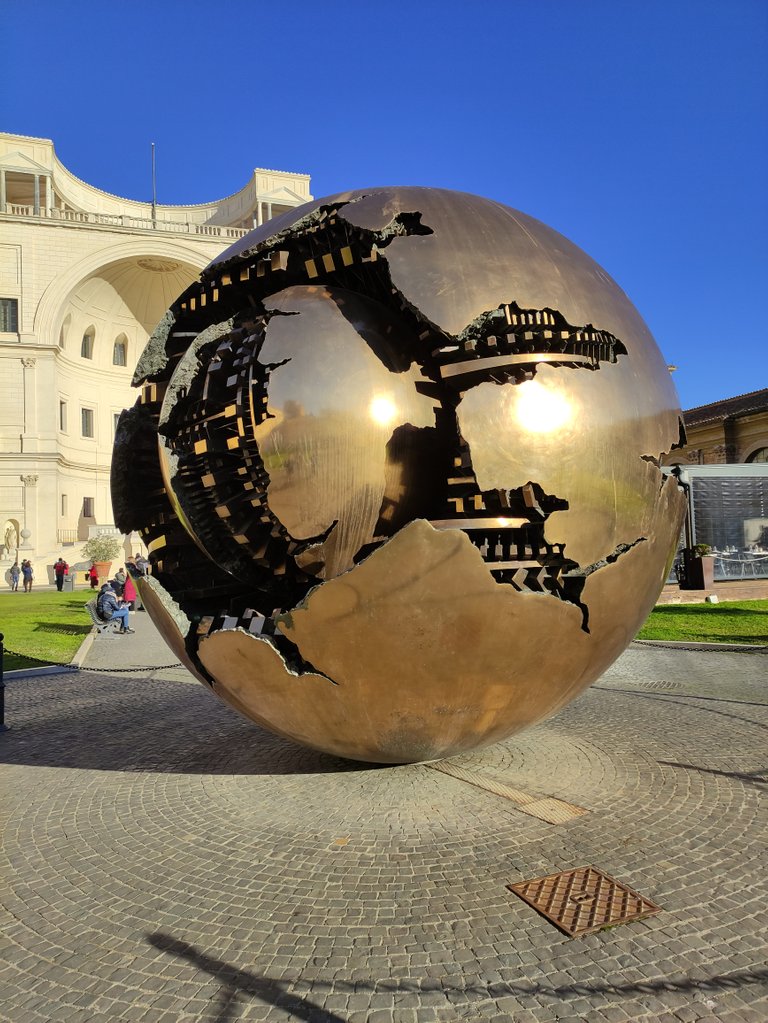
ITA - Sfera con sfera.
Stepping out into the courtyard you can admire the "sphere with sphere" made of bronze by Arnaldo Pomodoro with a diameter of 400 cm.
Uscendo nel cortile esterno è possibile ammirare la la "sfera con sfera" realizzata da Arnaldo Pomodoro in bronzo con un diametro di 400 cm.
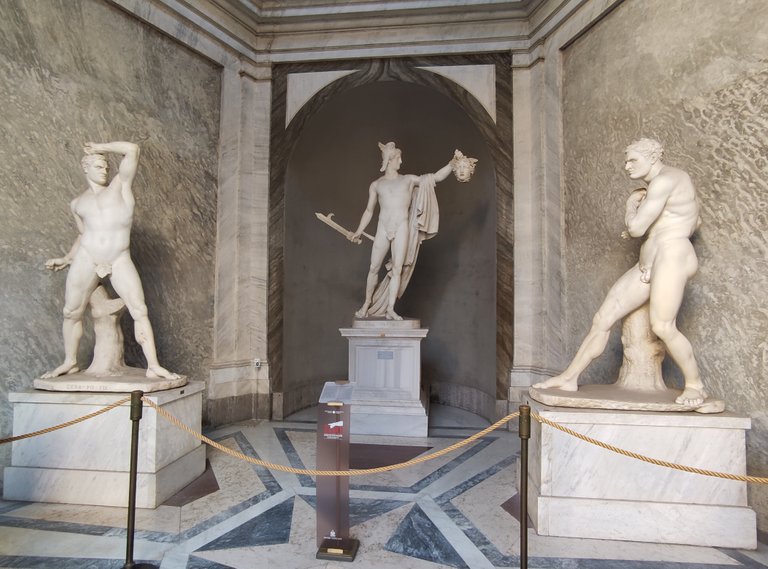
ITA - Perseo trionfante.
The statue represents Perseus triumphant after cutting off the head of Medusa, one of the three Gorgons. The hero wears a winged headdress, sandals made of mercury and the sickle given to him by the latter to decapitate Medusa. The work was sculpted by Antonio Canova in the space of a few months between the end of 1800 and the beginning of 1801.
La statua rappresenta Perseo trionfante dopo aver tagliato la testa di Medusa, una delle tre Gorgoni. L'eroe è munito di un copricapo alato, dei sandali di mercurio e del falcetto da questi regalatogli per decapitare Medusa. L'opera fu scolpita da Antonio Canova nel giro di pochi mesi tra la fine del 1800 e primi mesi del 1801.
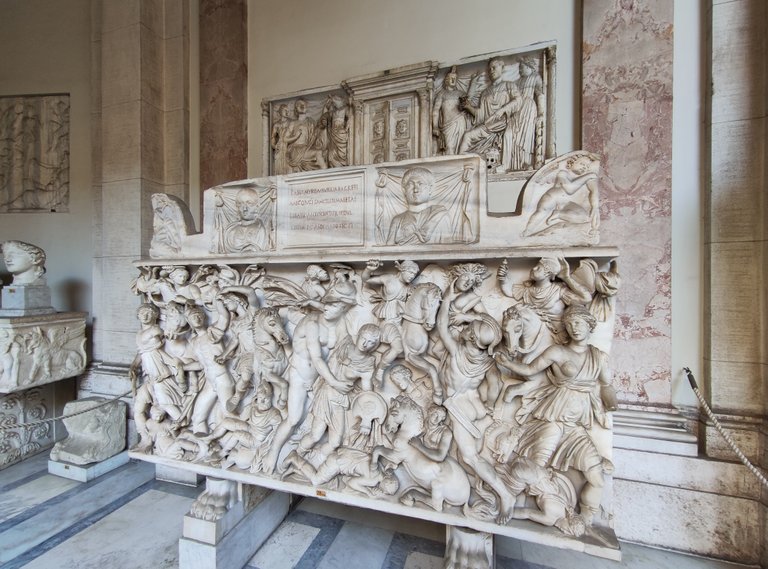
ITA - Sarcofago con Amazzonomacchia.
In this image we can see a sarcophagus representing a dense scene consisting of an amazzonomachia, i.e. a battle between Greeks and Amazons in which the leaders of the two sides, Achilles and Penthesilea respectively, stand out. Their faces have been characterised so as to take on the features of the dead, suggesting a date between 230 and 250 AD.
In questa immagine possiamo vedere un sarcofago rappresentante una fitta scena costituita da un amazzonomachia, ossia una battaglia tra greci e amazzoni nella quale campeggiano i capi dei due schieramenti, rispettivamente Achille e Pentesilea. I loro volti sono stati caratterizzati così da assumere le fattezze dei defunti che suggeriscono una datazione tra 230 e 250 d.C.
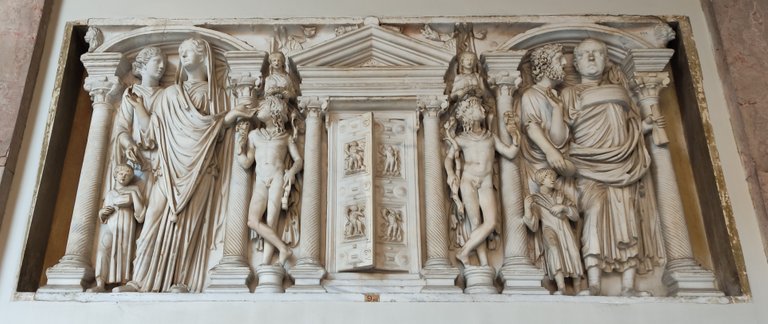
ITA - Sarcofago con entrata nell'Ade.
Here we can see the front of a sarcophagus, where on either side of the half-open door to Hades, the deceased, perhaps a married couple, are individually flanked by figures that could be Pluto and Proserpine, or Juno and a bearded genius; attendants appear in smaller sizes. Two genii of the seasons, on pedestals, are surmounted by victors bearing garlands.
Qui possiamo vedere la fronte di un sarcofago, dove ai lati della porta dell'Ade socchiusa, i defunti, forse una coppia di coniugi, sono singolarmente affiancati da personaggi che potrebbero essere Plutone e Proserpina, oppure Giunone e un genio barbato; inservienti compaiono in dimensioni minori. Due geni delle stagioni, su piedistalli, sono sormontati dalle vittorie che recano ghirlande.
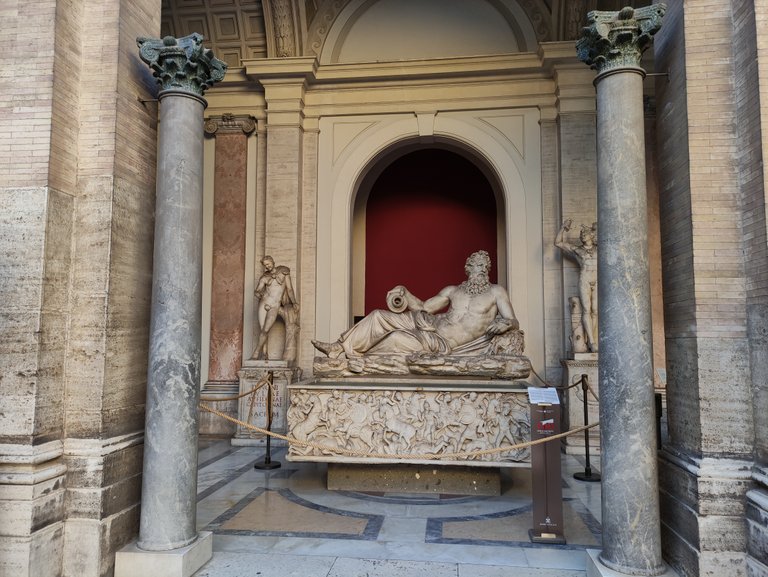
ITA - Divinità fluviale (Arno).
Here we see instead a statue of a river deity, with a characteristic semi-recumbent position, datable to the Hadrianic age and inspired by a Hellenistic prototype. It is assumed that this river deity is identified with the river Arno, although the presence of a feline in the sculpture, interpreted as a tiger, has in the past pointed towards the Mesopotamian river Tigris.
Qui vediamo invece una statua di una divinità fluviale, dalla caratteristica posizione semigiacente, è databile all'età adrianea ed ispirata a un prototipo ellenistico. Si suppone che tale divinità fluviale si identifichi con il fiume Arno anche se la presenza di un felino nella scultura, interpretato come una tigre, in passato ha orientato verso il fiume mesopotamico Tigri.

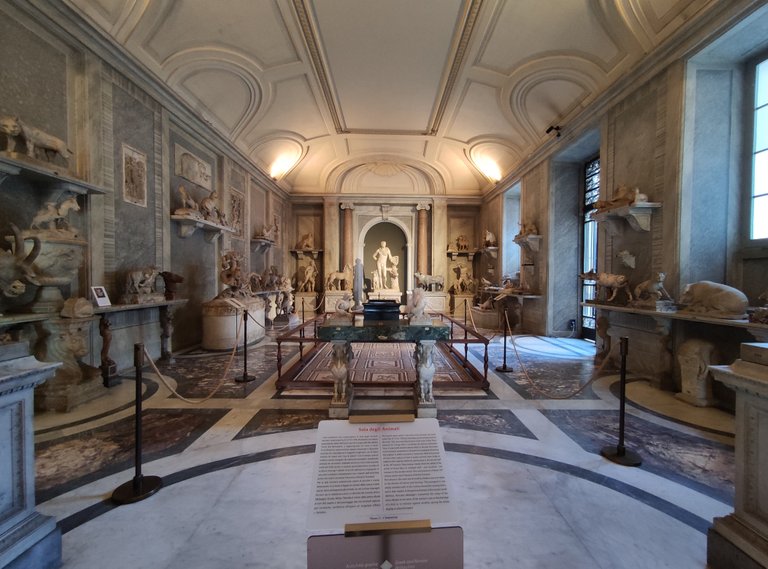
ITA - Sala degli animali.
In these photos we can see the famous Hall of the Animals, divided into two rooms and created under Pius Sesto by exploiting a pre-existing room. It contained ancient works, often restored and reworked to the point of distorting the original subject with the clear intention of creating a "stone zoo". Over time, this collection was supplemented by numerous specimens, mainly rare and exotic animals, also created from scratch from the second half of the 18th century. This very special collection of sculptures reveals the skill of artists who were competing with the masters of antiquity at the time, first and foremost Francesco Antonio Franzoni from Carrara. Small and medium-sized works were selected for the room, whose theme is linked to the world of nature and hunting. The protagonists are animals, both in their curious interaction with each other and in relation to heroes or deities of the ancient world (Beleager, Hercules, Mithras). Sometimes the colour of the stone alludes to the tones of the plumage of the various animals or, by contrast, gives the work a singular colouristic effect.
In queste foto possiamo vedere la famosa Sala degli Animali divisa in due ambienti e creata sotto Pio Sesto sfruttando una stanza preesistente. Vi confluirono opere antiche, spesso restaurate e rilavorate al punto da stravolgerne il soggetto originario con il chiaro intento di creare uno "zoo di pietra". Con il tempo questo insieme venne integrato da numerosi esemplari, soprattutto animali rari ed esotici, realizzati anche ex novo dalla seconda metà del XVIII secolo. In questa particolarissima raccolta di sculture emerge l'abilità di artisti all'epoca impegnati in una vera e propria competizione con i maestri dell'antichità, primo fra tutti il carrarese Francesco Antonio Franzoni. Per la sala vennero selezionate opere di piccola e media dimensione, il cui tema è legato al mondo della natura e della caccia. Sono protagonisti gli animali, sia del curioso interagire fra loro, sia in relazione a Eroi o a divinità del mondo antico (Beleagro, Ercole, Mitra). Talvolta il colore della pietra allude ai toni del manto del piumaggio dei vari animali oppure, per contrasto, conferisce all'opera un singolare effetto coloristico.
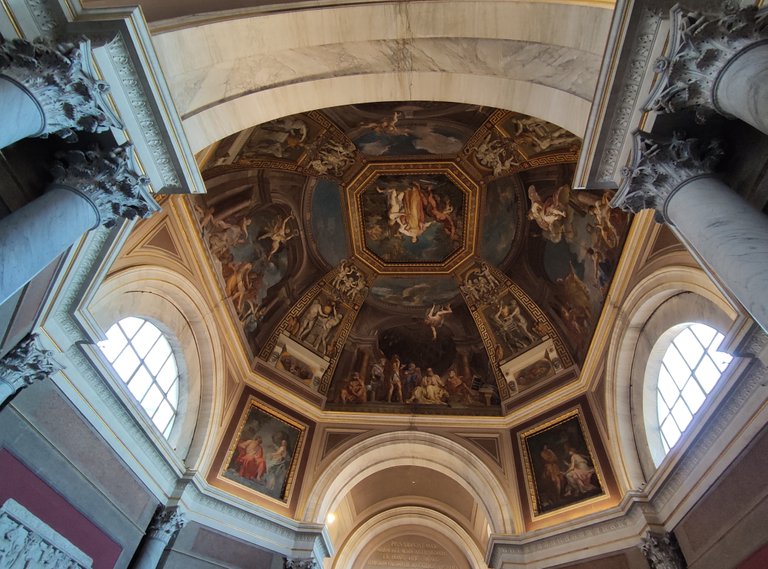
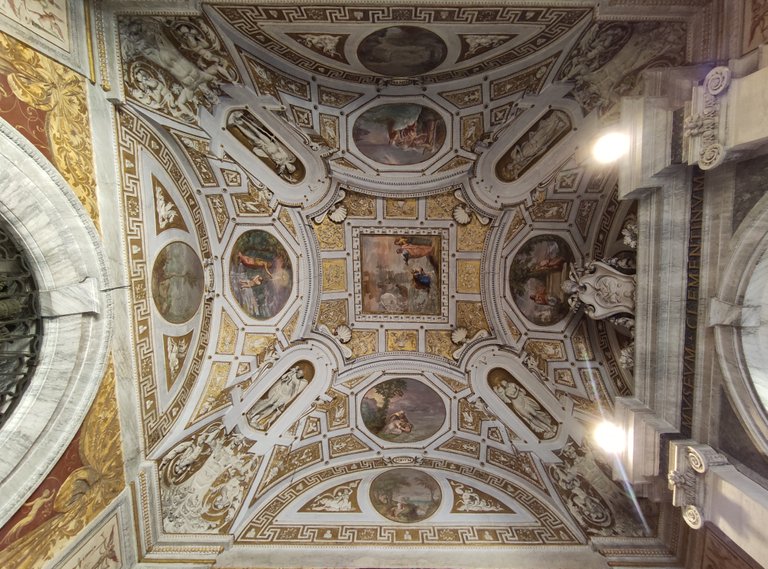
ITA - Due dei tanti meravigliosi soffiti afrescati.


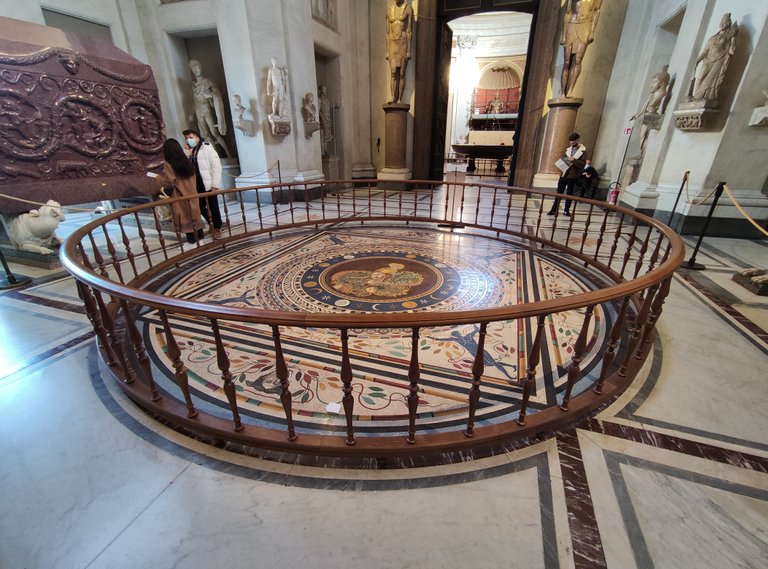
ITA - La Sala Rotonda.
Next we move to the Round Hall, a large room with a hemispherical vault, in imitation of Hadrian's Pantheon, which was completed in 1779 according to a design by Michelangelo Simonetti. The floor is made up of certain mosaics from the Roman era, mostly from contemporary excavations; it is an admirable assemblage of mosaic panels depicting the struggle between the Lapiths and Centaurs is a series of Marinian courtesans. In the centre of the room is a large red porphyry cup.
Di seguito ci spostiamo nella sala rotonda, una grande sala con una volta emisferica, a imitazione del Pantheon adrianeo, che venne completata nel 1779 secondo un progetto di Michelangelo Simonetti. Il pavimento è costituito dalla certi musivi di epoca romana provenienti in massima parte da scavi coevi; si tratta di un mirabile assemblaggio di pannelli musivi raffiguranti la lotta tra i lapiti e centauri è una serie di corteggi Marini. Al centro della sala è collocata una grande tazza in porfido rosso.
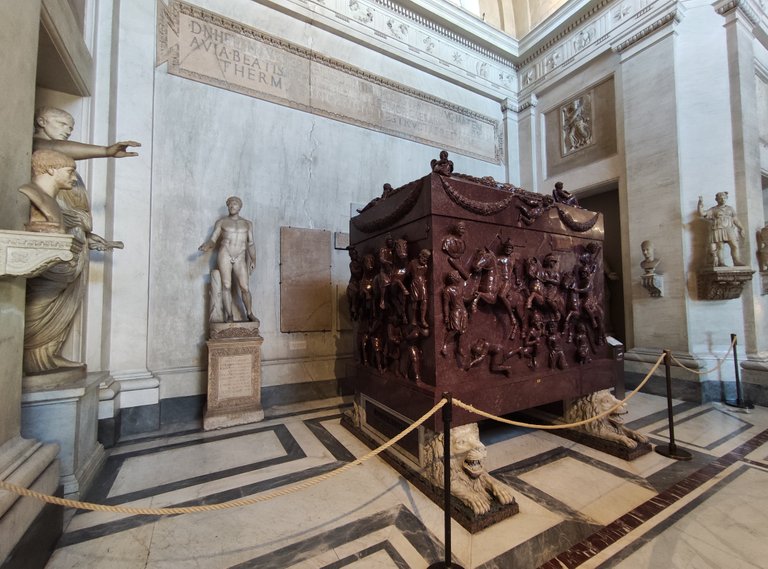
ITA - Il sarcofago in porfido rosso.
The monumental red porphyry sarcophagus was made to hold the remains of Helena, Constantine's mother, who died around 335 AD. On the coffin are military scenes in which Roman knights subdue barbarian prisoners; on the lid, figures of heroes and winged victories hold garlands, while two lions, one sleeping, the other crouched, occupy the slopes. The military subject matter, hardly suitable for a female structure, suggests that the sarcophagus was originally intended for a male member of the imperial family.
Il monumentale sarcofago in porfido rosso fu realizzato per raccogliere le spoglie di Elena, madre di Costantino, morta intorno al 335 d.C.. Sulla cassa compaiono scene di carattere militare, in cui Cavalieri Romani sottomettono i prigionieri barbari; sul coperchio, figure di eroi e di vittorie alate reggono ghirlande, mentre due leoni, uno dormiente, l'altro accucciato, occupano gli spioventi. Il soggetto militare, poco adatto alla struttura femminile, fa supore che il sarcofago fosse originariamente previsto per un componente maschile della famiglia Imperiale.
ENG - I hope that you enjoyed this virtual tour as much as I enjoyed visiting them. In the the next post I will continue with this virtual trip through this amazing museum.
ITA - Spero che vi sia piaciuto questo tour virtuale tanto quanto è piaciuto a me visitarli. Nel prossimo post continuerò con questo viaggio virtuale attraverso questo incredibile museo.

hive-163772
ocd
oliodibalena
neoxian
palnet
creativecoin
photograpylovers
curator
traveldigest
haveyoubeenhere
0
0
0.000
Congratulations, your post has been added to Pinmapple! 🎉🥳🍍
Did you know you have your own profile map?
And every post has their own map too!
Want to have your post on the map too?
Bellissimo post, Grazie della condivisione :)
@tipu curate
Upvoted 👌 (Mana: 58/78) Liquid rewards.
Your content has been voted as a part of Encouragement program. Keep up the good work!
Use Ecency daily to boost your growth on platform!
Support Ecency
Vote for new Proposal
Delegate HP and earn more
Congratulations @aurzeq! You received a personal badge!
Participate in the next Power Up Day and try to power-up more HIVE to get a bigger Power-Bee.
May the Hive Power be with you!
You can view your badges on your board and compare yourself to others in the Ranking
Check out the last post from @hivebuzz:
Support the HiveBuzz project. Vote for our proposal!